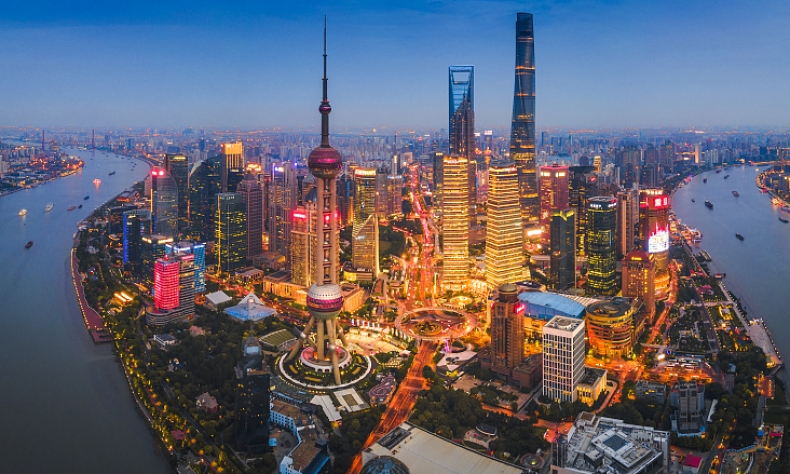An Innovation Superpower in Making

Shanghai is aptly utilising the new round of technological and industrial revolution to effectively revitalise its traditional industries.
Technological innovation is the starting point for the development of new quality productive forces. This process involves transforming traditional industries and nurturing emerging sectors, ultimately leading to a significant qualitative leap in productivity.
Shanghai, propelled by technological innovation, has undertaken the restructuring of traditional industries while pioneering new ones. This strategic approach has led to numerous groundbreaking achievements, some of which are unprecedented, thereby raising the level of productivity. This concerted effort has facilitated a significant leap forward in the development of new quality productive forces.
Enterprises in Shanghai have embraced digital and green technologies extensively to drive the transformation and upgrading of traditional industries. Innovation has led to development of new products, technologies, and production modes across sectors such as materials, nuclear power, shipbuilding, port machinery, and power electronics. These advancements have fundamentally transformed these industries, significantly boosting efficiency and profitability. Such achievements reflect the decade-long devotion to technological innovation that demands sustained investment, continuous accumulation of experience, and iterative improvements over the years.
Shanghai stands as a testament to these efforts, showcasing numerous successful examples of innovation-driven industrial revitalisation.
The Shanghai Synchrotron Radiation Facility began construction on 25 December 2004, and officially opened to users on 6 May 2009. Baosteel’s cold rolling production line underwent a decade-long digital and intelligent transformation to enhance its operation. China’s first large domestic cruise ship, the Adora Magic City, went into operation after eight years of research and five years of design and construction. Adhering to the concept of “making progress in light of the past, tackling present challenges, and developing the future,” Shanghai Electric Nuclear Power Group maintains a strong focus on technological innovation and achieves notable breakthroughs annually.
Through robust technological innovation, Shanghai has aptly seized the opportunities presented by the intelligent and green development in the new round of technological and industrial revolution, effectively revitalising its traditional industries.
Accumulation of resources
The integration and interconnection of multiple disciplines, along with technological breakthroughs, represent key features of the new round of technological and industrial revolution. Fostering emerging and innovative industries necessitates a high-level reorganisation of productive factors and innovation. An effective innovation ecosystem, abundant in resources and facilitating interactive development among entities, is crucial for generating new quality productive forces. Shanghai leverages its scientific and research resources, alongside its industrial base, to stimulate the growth of new quality productive forces through three levels of accumulation measures.

At the macro-level, Shanghai has positioned itself as the international centre for economy, finance, trade, shipping, and science and technology, fostering synergy among these sectors. As the international centre for finance, Shanghai has developed a high-tech financial system that supports the entire lifecycle and chain of scientific innovation.
At the meso-level, Shanghai has established a diverse array of business incubator and specialised industrial parks to promote extensive integration across the innovation chain, industrial chain, financing chain and talent chain, creating endless possibilities through communication and exchange. With a focus on innovation sourcing, NeoBay Global Innovation Community has gathered two universities, over 10 scientific research institutes and approximately 200 R&D organisations at different levels, forming close cooperation mechanisms among institutes, enterprises and the government.
Furthermore, Shanghai MedValley has pioneered a collaborative model between the medical domain and related industries through the establishment of the Ruijin Hospital Innovation Centre. The SMC Shanghai Foundation Model Innovation Centre plays a pivotal role in supporting businesses by creating a comprehensive AI foundation model innovation ecosystem.
At the micro-level, Shanghai has strategically positioned itself as a magnet for top global talent by establishing high-end platforms, and strengthening its position to advance towards the forefront of world science and technology. Such facilities of Shanghai, including the Experimental Platform for Laboratory Astrophysics, the Experimental Platform for Topological Materials, the Supporting Platform for Large-Scale Scientific Computing of the Tsung-Dao Lee Institute and the Shanghai Synchrotron Radiation Facility, provide services for cutting-edge scientific research globally. Such initiatives are pivotal in attracting future-oriented industries to establish a presence in the city.
Optimising innovation ecosystem
Looking into the future, a more focused and integrated approach to technological innovation will further fuel the development of new quality productive forces. Investment in foundational and emerging fields such as 6G, AI, quantum technology, synthetic biology, and humanoid robots will be raised and a system of innovation chain will be created to lay a solid scientific and technological foundation necessary for building leading positions in future-oriented industries.
In addition, support and incentives for long-term, high-risk, and high-value technological innovation will be enhanced, and researchers are expected be encouraged to engage in long-term research projects on critical issues with major significance. Investment in early-stage, small-sized, and cutting-edge technology enterprises should be optimised.
The city will establish more platforms capable of aggregating high-quality innovation factors and connecting the front and back ends of innovation chain as well as the upstream and downstream of the industrial chain. Enhancing innovation mechanisms will facilitate integrated innovation to foster a robust innovation ecology, which will in turn support the development of new quality productive forces.
The author is Researcher of Chinese Academy of Science and Technology for Development.
 Facebook
Facebook
 Twitter
Twitter
 Linkedin
Linkedin
 Google +
Google +










